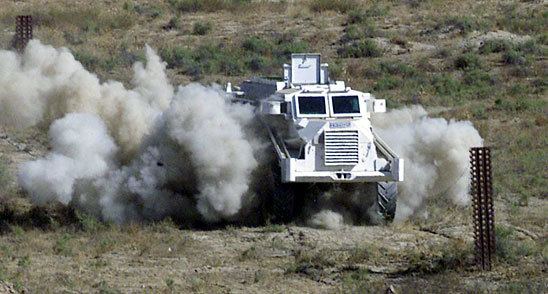Length 6.9 m (22.64 ft) Height 2.85 m (9.35 ft) | Weight 10.88 t Width 2.45 m (8.04 ft) | |
 | ||
Type Mine-Resistant Ambush Protected Vehicle | ||
The Casspir is a Mine-Resistant Ambush Protected Vehicle that has been in use in South Africa for over 30 years. It is a four-wheeled, four-wheel drive vehicle, used for transport of troops. It can hold a crew of two, plus 12 additional soldiers and associated equipment. The Casspir was unique in design when launched, providing for passive mine defence. The main armoured steel body of the vehicle is raised high above the ground, so when a mine is detonated, the explosion is less likely to damage the crew compartment and kill the occupants. The cross-section of the hull is V-shaped, directing the force of the explosion outwards, further protecting the occupants. The vehicle also offers crew protection from small arms fire. The capabilities of the Casspir were the basis of the outline capabilities required by the U.S. Marines' for their Mine Resistant Ambush Protected or MRAP vehicle project.
Contents
Design history
The name 'Casspir' is an anagram of the abbreviations of the customer, the South African Police (SAP), and the design authority, the Council for Scientific and Industrial Research (CSIR - Applied Chemistry Unit that later became MECHEM). Although the Casspir was deployed in townships during the apartheid era, it was initially designed specifically for conditions encountered in the South African Border War. It was at first extensively used by the infamous "Koevoet" police counterinsurgency unit in northern Namibia during the apartheid era and later also by the South-West Africa Territorial Force's 101 Battalion and the SA Army's 5 Reconnaissance Regiment. The chief criteria for the design was good off-road mobility, armour protection against small arms fire and anti-personnel mines, and ease and speed of repair by a light workshop crew in the field after detonating an anti-tank mine. These requirements led to the distinctive V-shaped hull (for mine protection) and a wheeled chassis.
The Casspir was designed by the Defence Research Unit (DRU) of CSIR specifically to protect vehicle occupants against landmines. It is certified to protect its occupants against a triple TM-57 mine blast (equivalent to 21 kg of TNT) under a wheel, or a double blast (14 kg of TNT) under the hull. The Casspir has V-bottomed armoured monocoque hull, designed to deflect the force of an explosion outwards, to which a leaf-spring suspension is attached.
Production history
After two years of field testing, the South African Police were eventually satisfied they had a good vehicle and in March 1980 placed an order for an initial 140 Casspirs. Some 190 Mk1 Casspir were manufactuered by Henred Fruehauf. In 1981 production was taken over by TFM, which improved the design to the Mk 2. TFM was subsequently taken over by Reumech OMC. Reumech in turn was taken over by Vickers Defence Systems of the UK and renamed Vickers OMC. When Alvis purchased Vickers Defence Systems to become Alvis Vickers, Vickers OMC became Alvis OMC. In 2004 BAE Systems acquired Alvis Vickers and Alvis OMC was renamed Land Systems OMC. Land Systems OMC was 75 per cent acquired by Denel in 2015. An estimated 2800 Casspir of all types have been built.
The South African Police Service auctioned off some of their surplus Casspirs to the public at a 2008 auction. A new Casspir known as Casspir NG 2000 is being manufactured by Denel Mechem. The vehicle was launched in April 2013.
Variants
The Casspir was built in different configurations:
Operators
Combat history
Popular Culture
The Casspir has entered South African popular culture as an icon of apartheid-era state repression. An embroidered Casspir, with Ndebele designs, outside the Iziko South African National Gallery was installed as a representation of this iconography of the vehicle. A Casspir also forms part of the South Africa Apartheid Museum's exhibit on repression in the townships in the 1980s.
